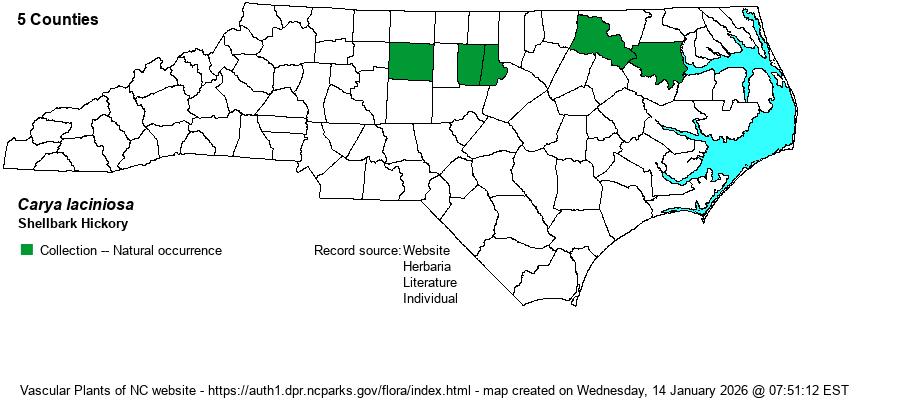| Author | (Michaux fils) W.P.C. Barton | |
| Distribution | Known only from a few sites along the Roanoke River in far eastern Halifax County and adjacent Bertie County, in the northwestern Coastal Plain; and a few sites in the northeastern Piedmont, where currently known from just Durham County. Because these sites are disjunct from WV, KY, and TN, with still no confirmed record from VA, some have speculated that the NC records might have been from historical plantings. This seems implausible, as the Durham and Roanoke River sites are in high quality brownwater floodplains.
Primarily found west of the Appalachians, from western NY to IA, and south to eastern OK and central AL. There are no records (at least confirmed) from VA, SC, FL, or TX.
| |
| Abundance | Very rare in rich floodplains in the northern part of the Coastal Plain and eastern Piedmont. This is a State Threatened species. | |
| Habitat | This is a species of rich bottomlands and natural levees, almost always in circumneutral soil, or at least where there has been considerable deposition of silt from flooding, such as on natural levees along the Roanoke River. However, plants in NC do not grow in swamps. |
| Phenology | Flowers in April and May, and fruits in October. | |
| Identification | Though reasonably familiar to biologists in the Ohio River drainage, very few field workers have seen this tree in NC. This is a large deciduous tree, at times growing over 100 feet tall. As with Shagbark Hickory (C. ovata), this tree also has shaggy gray bark, though on younger trees the bark is not as loose as seen on the other species. This species can be told from all others in the state by a combination of 1) shaggy bark, 2) normally 7 leaflets, and 3) very large leaflets, with the terminal one being quite large (6-8 inches long), much larger than on other hickories. In fact, the large leaflets, especially the terminal one, look quite similar to the single leaves of Common Pawpaw (Asimina triloba), which may grow with it. In addition, the fruit is very large, almost the size of a baseball; if you were hit by one dropping out of a tree, it could produce a head injury. Lastly, in the fall, the leaflets often drop off the rachis, without the petiole/rachis also dropping, leaving an odd look of “twigs” at the end of a branch! | |
| Taxonomic Comments | None
| |
| Other Common Name(s) | Big Shellbark Hickory, Kingnut Hickory | |
| State Rank | S1 | |
| Global Rank | G5 | |
| State Status | T | |
| US Status | | |
| USACE-agcp | FACW link |
| USACE-emp | FAC link |

